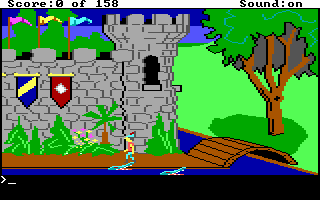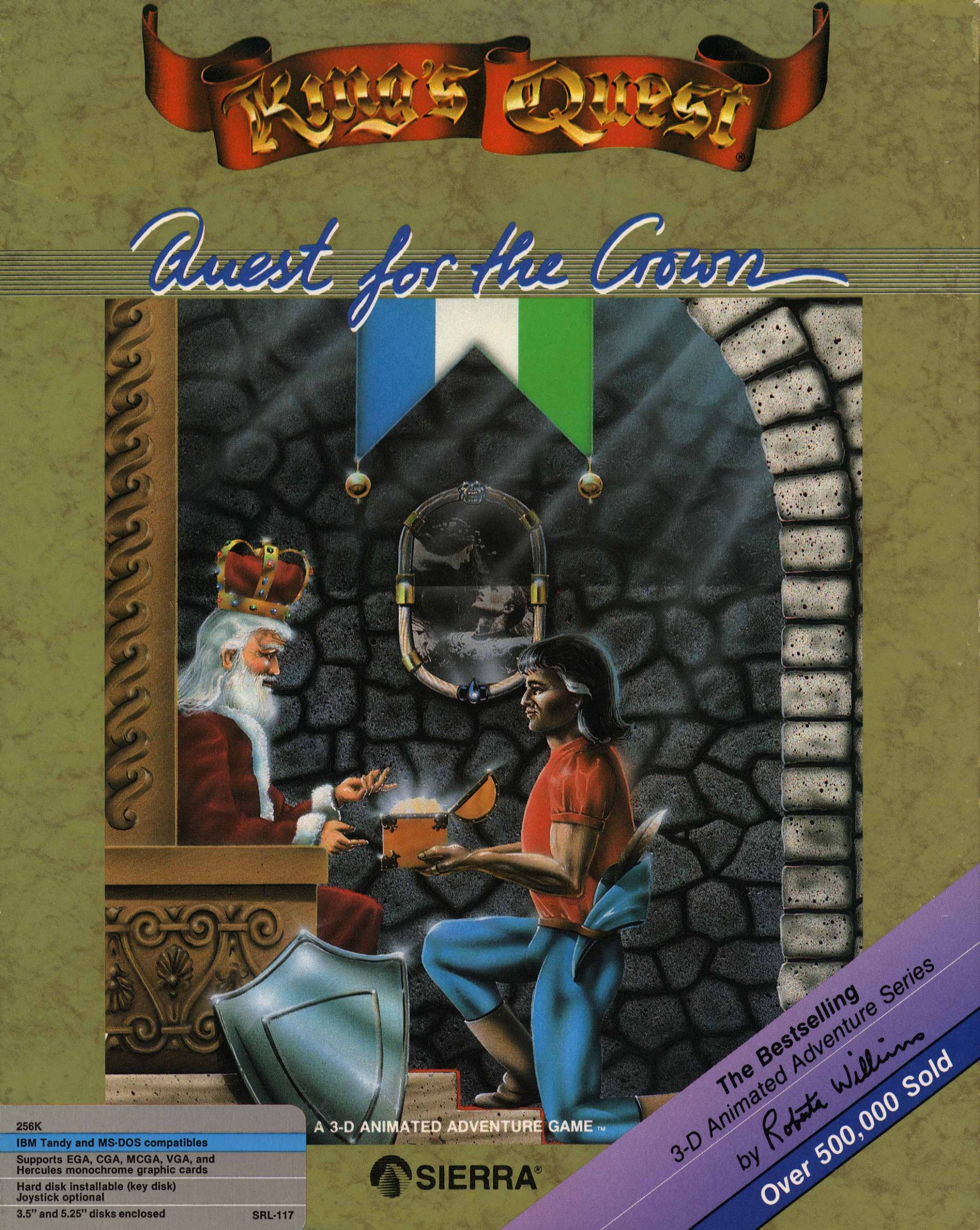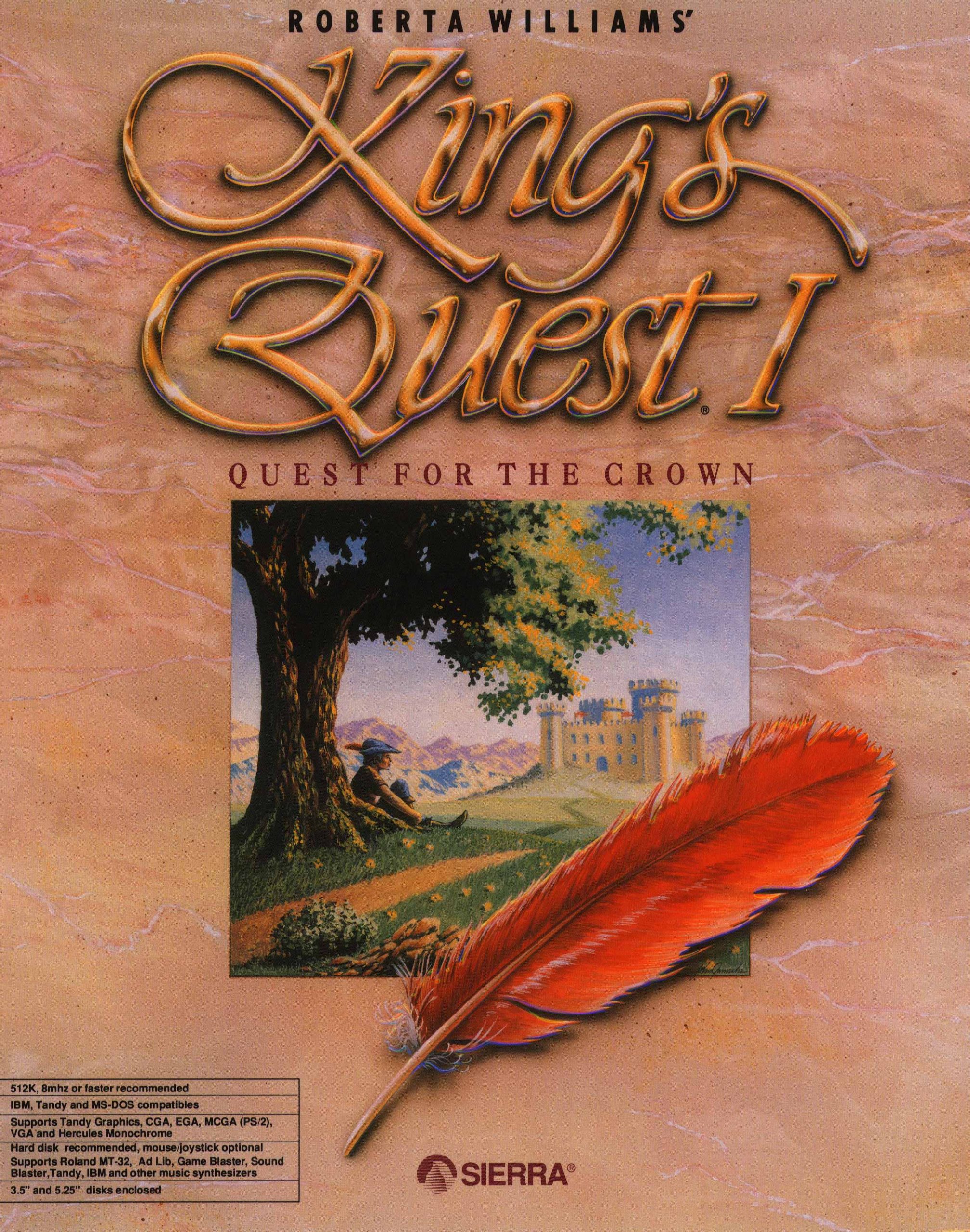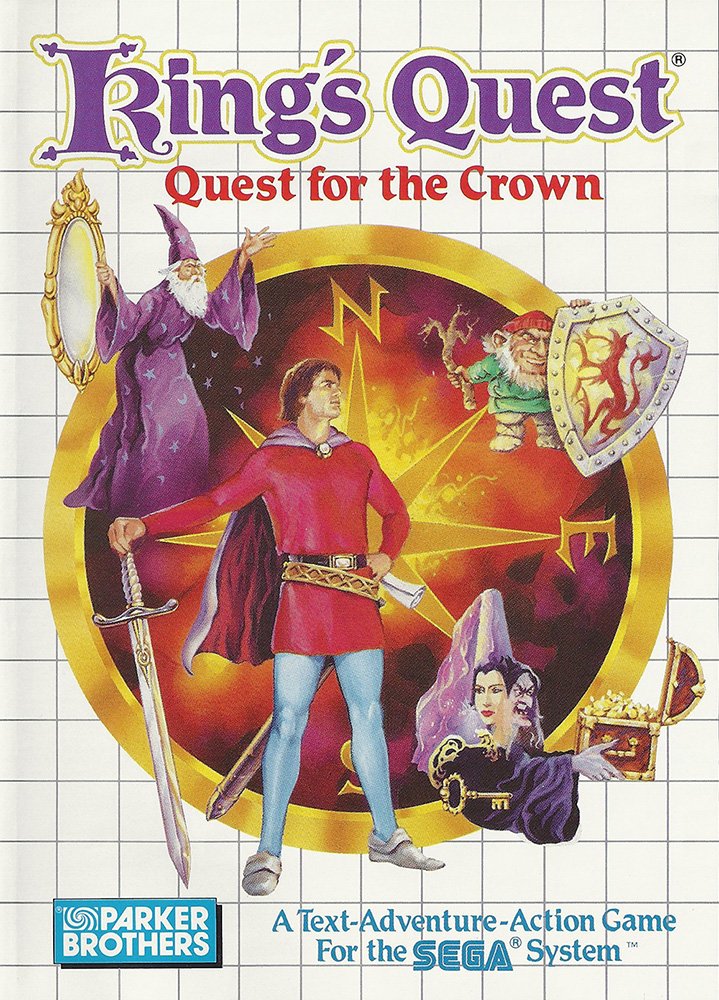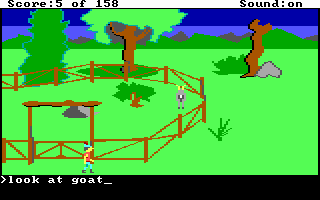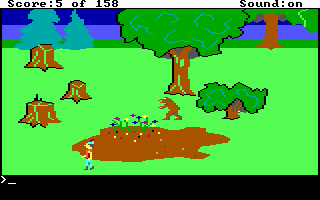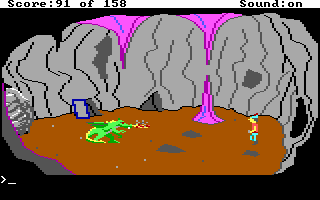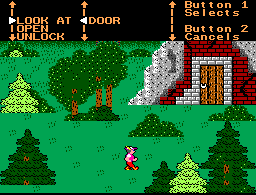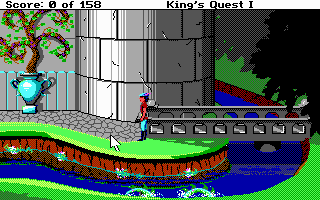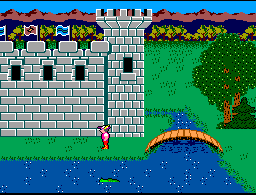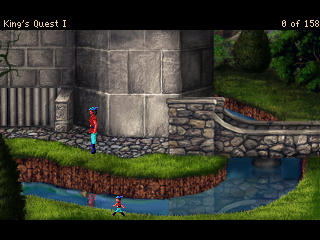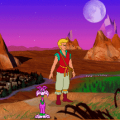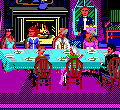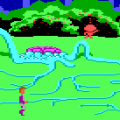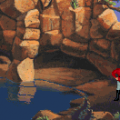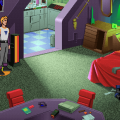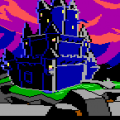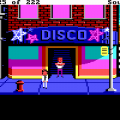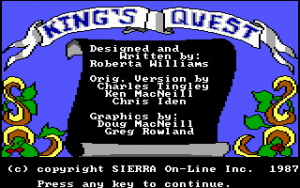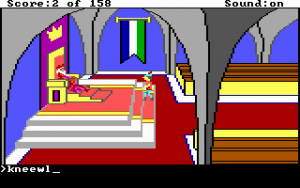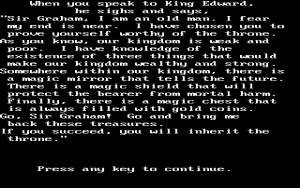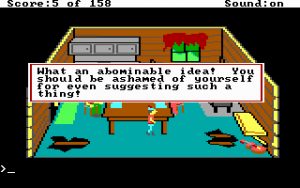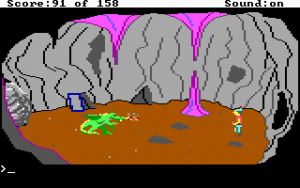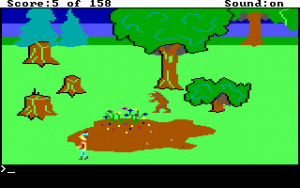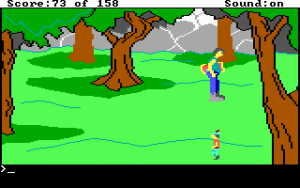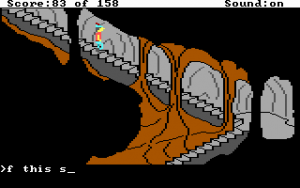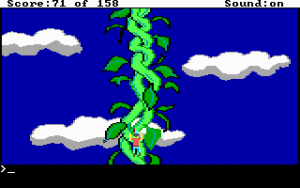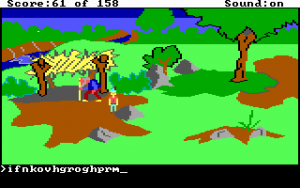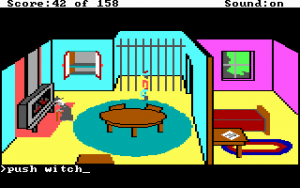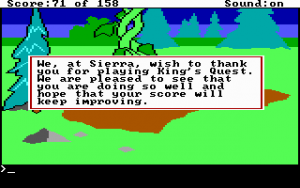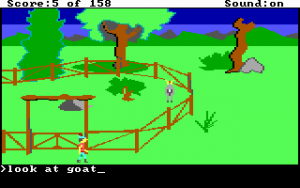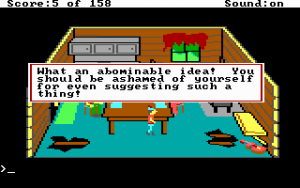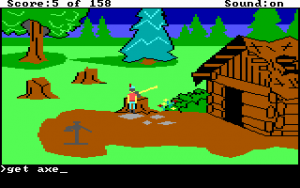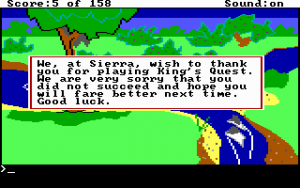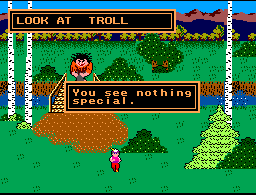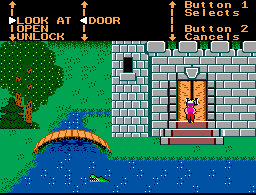- King’s Quest: Quest for the Crown
- King’s Quest II: Romancing the Throne
- King’s Quest III: To Heir is Human
- King’s Quest IV: The Perils of Rosella
- King’s Quest V: Absence Makes the Heart Go Yonder!
- King’s Quest VI: Heir Today, Gone Tomorrow
- King’s Quest VII: The Princeless Bride
- King’s Quest: Mask of Eternity
- Silver Lining, The
Ostensibly Sierra’s flagship series, King’s Quest is practically the progenitor of the graphic adventure genre as we know it. Designed and conceived by Roberta Williams, it sought to break free of text adventure conventions by switching to a third person view, giving the player an avatar to guide around the game world. It was also at the forefront of their technological advancements. Every time Sierra introduced a new engine, with improvements to the graphics, sound and interface, King’s Quest was always the title leading the way.
In many ways, the quality of the King’s Quest games have been surpassed by other titles – while innovative, Sierra’s other games were often better designed and more inspired. But the series still has a style all of its own, however quaint it may be. The world of King’s Quest takes the basic medieval tropes – knights and dragons, swords and sorcery – but draws heavily from classical mythology and folklore from all kinds of cultures. It’s sort of a weird hodge podge, where you run into Little Red Riding Hood one moment and Count Dracula the next, but the occasional twists on the formula make for some interesting scenarios.
Each game stars one of the members of the royal family of Daventry. The first game puts you in the shoes of Sir Graham, a loyal knight who is chosen to take over rule of the country. In the second game he seeks a bride, the beautiful Valanice. The third game appears unrelated, putting you in the role of a young boy enslaved to a wizard, but at the end it’s revealed he’s actually Alexander, the long missing son of Graham and Valanice. The fourth game features their daughter, Princess Rosella, as she teleports to another land to save her father. The fifth game returns you to the role of King Graham, now with graying hair but still a strong adventuring spirit, to rescue his kidnapped family. The sixth game features Alexander again, now a proper prince, as he seeks a wife, much like his father had done four games before him. And the seventh game features both the return of Rosella and the first adventure for Queen Valanice, now a rather grandmotherly woman. The eighth and final game breaks from this tradition and has little to do with anything. Although each game takes place in completely different lands – Daventry, Kolyma, Llewdor, Tamir, Serenia, Land of the Green Isles and Eldritch – there are some small elements of continuity, particularly in the later games.
The Great King Edward, kind ruler of the Kingdom of Daventry, is old and frail. With no heirs, he tasks his loyal knight, Sir Graham, with a quest: hunt down three magic artifacts and bring them back, and he shall bequeath the throne. This is about all the guidance you get, and Graham is left to wander the land searching for them. The artifacts include the mirror, which can predict the future and is guarded by a fire-breathing dragon; the shield, which can protect the user from mortal harm and has been stolen by a group of leprechauns; and the chest, which has a limitless supply of gold coins and is in the possession of a giant who lives up in the clouds.
Daventry runs eight screens east and west, and six screens north and south, wrapping around infinitely. The supplementary documentation explains this bit of video game phenomenon as “The Magical Law of Containment”, which prevents characters from leaving the land. At least a few of the essential items are found simply by looking in tree stumps or moving rocks. Some puzzles involve a degree of knowledge of fairy tales – it’s quite fun to enter the gingerbread house, open up the stove, hide in the back room, wait for the witch to enter, and then shove her into the flames. Less fun is trying to guess the name of the mysterious gnome. It’s pretty clearly supposed to be Rumpelstiltskin, with a twist – you’re supposed to “think backwards”. One would assume that you simply spell his name in reverse, but no – it’s his name spelled in the backwards alphabet, with Z being substituted for A, Y for B and so on. Therefore, the correct solution is actually “Ifnkvohgroghprm”, which is ridiculous. The 1990 remake actually fixes this puzzle so the game will accept the more logical “Nikstlitslepmur”.
To the game’s credit, this puzzle isn’t mandatory – you get a bag of beans, which is used to plant a beanstalk and climb into the sky. But there’s another way to enter the sky realm without dealing with the troublesome gnome, one which yields less points, but is still as effective. You can also dispose of your enemies in a variety of ways, although the game yields more points for the less violent (and thus arguably cleverer) methods. Try dousing the dragon with a bucket of water, for example, rather than throwing a dagger at it.
In an attempt to make the experience more like an arcade game, there are also other enemies that appear throughout the land. They each inhabit certain screens, although their appearance is random. These baddies include dwarves, who can steal your treasure, effectively sticking you in a dead end situation since they can’t be recovered; enchanters, who can paralyze you for other enemies to take you out; and wolves, which will eat you outright. All of these can be avoided by leaving and re-entering the screen. More perilous are the lakes, rivers and cliffs throughout Daventry. Graham can swim in certain bodies of water, but you need to type “swim” within a few seconds or else he’ll stupidly drown. It’s extremely easy to walk into the moat right on the first screen, immediately disposing of your hero before he can even talk to the king. More annoying is the beanstalk climbing sequence, which suffers from utterly terrible collision detection and will send you falling to the ground at seemingly random points, or the stair-climbing segment, which requires careful navigation lest you accidentally fall to your doom. These “arcade sequences” were a notorious part of Sierra’s AGI games, although it’s surprising to say that this, the first King’s Quest, is far from the worst of them.
The music is of course sparse, with the main theme being a simple rendition of “Greensleeves”. Outside of occasional sound effects and various ditties, the only other music is played when you die, which is a standard death theme with a jaunty little finish. The Game Over window includes a message from Sierra thanking you for playing and even offers some encouragement if your score is high enough.
King’s Quest is, of course, a simple game, one which may seem borderline unplayable compared to the numerous adventure games that succeeded it. Its historical importance can’t be denied though. With a bit of patience, transport yourself into the mindset of a computer user in the mid-1980s, long before the internet became widespread, when hard disks were insanely expensive, and 128k was a helluva lot of RAM. When PCs were mostly used for business applications and many games were, at best, shifty arcade ports or amateur software, King’s Quest was a fantastic world inside your computer, one which was more than a series of static screens, with lush scenery and terrifying monsters, and which promised hours upon hours of adventure. It might be hard to appreciate now, but it was an amazing accomplishment at the time.
King’s Quest was initially released for the PCjr in 1984. Due to the unpopularity of the platform it went largely unnoticed until it was ported to other computers, where it sold substantially better. Although it loads instantly when installed on the hard disk on DOS-based computers, many other ports were not so lucky. In versions such as the Apple II port, disks need to be swapped continuously and it takes several seconds to load each screen, as it slowly draws the outline of the scenery and then fills in the color.
In 1989, King’s Quest was ported to the Sega Master System and published by Parker Brothers, one of the only third-parties to release games for the system. The Master System has both a larger color palette and a higher resolution, so the game doesn’t look nearly as blocky. However, due to the limited ROM space and the tile-based nature of 8-bit console graphics, many of the areas lack the detail of the PC version. Since there’s no keyboard, actions are accomplished by accessing a menu, which lists all possible verbs and nouns available for the current screen. While cumbersome, it makes dealing with the game’s limited vocabulary much easier. Since the cartridge lacks a battery backup function, progress is saved via a password.
As the years went on, Sierra eventually upgraded its interpreter to allow for higher resolution and better controls. They also decided to remake some of their earlier games using this improved technology. King’s Quest was the first to receive this treatment, using the SCI0 interpreter – and it was also the only remake under SCI0. The other Sierra remakes, including Space Quest, Leisure Suit Larry, Police Quest, Mixed-Up Mother Goose, and Quest for Glory, used the more advanced SCI1. While still limited to a 16 color palette, the resolution is doubled, allowing for much, much more detailed characters and backgrounds. The visuals are entirely new, and are a vast improvement over the original’s. However, the revised version of Daventry is much darker and more foreboding than the lush, bright greens in the Daventry of old. The enemies still pop up, but rather than appearing right when you enter the screen, they won’t show up until you’ve wandered into the middle, making it harder to run away from them.
Although it’s limited to a text input parser, you can at least use the mouse to control Graham’s movement. Although the plot is still sparse, there’s more writing when you examine things or are killed. This is where the awful death puns that became a King’s Quest trademark first popped up – try getting kidnapped by the witch in the candy home to be turned into a “Graham cracker”. There are more cutscenes too – the part where Graham walks into the castle and talks to the king is controlled entirely by the computer. A few puzzles have changed, and now there’s a particular order to find the treasures. You can find the mirror or the chest whenever you like, however, the shield must always be found last.
In 2001, a fan group called AGD Interactive remade King’s Quest I using the Adventure Game Studio engine. In addition to using a fully icon-based parser, all of the visuals have been upgraded to 256 colors, looking much like Sierra’s VGA games. The artwork is all based on the 1990 remake, so it looks quite similar in style. Most of the text is taken from this version as well, although it’s all fully voiced. Josh Mandel, the Sierra designer/writer who voiced King Graham in the CD-ROM version of King’s Quest V, returned to provide his voice, which is quite classy. The project has been updated several times since its initial release, substantially improving it over time.
Screenshot Comparisons
The King’s Quest Companion / King’s Quest Novels
While Sierra often published its own hint books, more interesting were the Companion books. Rather than just having standard walkthroughs, they contained novelizations of the games, allowing the reader to experience the story and events without having to play them, although it obviously gave useful hints. This was not unique amongst King’s Quest, but this particular book is far better written than the rest. Many others told the events from the first person view of the characters, which read terribly. Here, the viewpoint is told from the third person. The author, Peter Spear, made up a character named Derek Karlavagen, a historian, and all of the stories are meant to be interviews told from the viewpoint of the hero. They’re actually quite enjoyable and worth reading alongside the games.
There are also three novels based on the series, each with original stories. The Floating Castle stars Alexander as he reclaims the stolen soul of his father; The Kingdom of Sorrow stars Graham as he saves the personification of spring to prevent an endless winter; and See No Weevil stars Rosella, whose snootiness causes a plague of weevils to cover the land.
